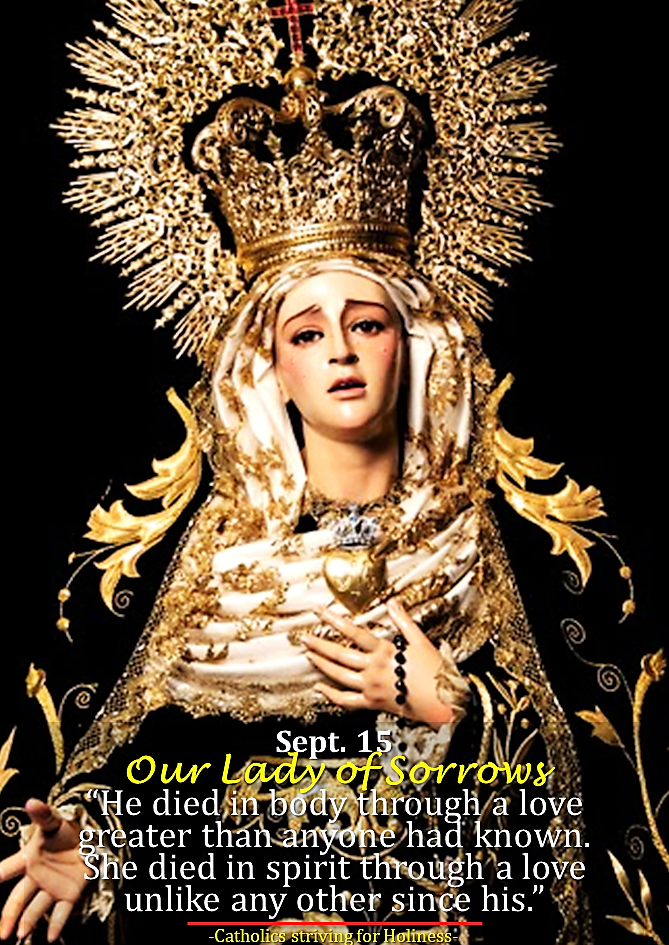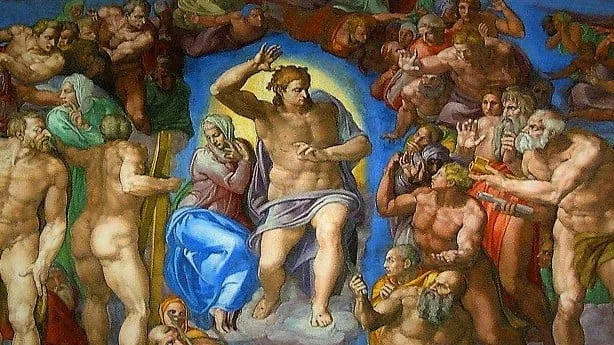Sept. 15
OUR LADY OF SORROWS
Feast+ Gospel reading + Divine Office 2nd reading

OUTLINE
- Feast introduction
- GOSPEL AND COMMENTARY: John 19:25–27
- DIVINE OFFICE 2ND READING: A sermon of St Bernard. His mother stood by the cross
1. Feast introduction
This feast has its origin in that Christian devotion which associates her with the Passion of her Son. Pope Pius VII extended this devotion to the whole Church and, in 1912, St. Pius X fixed the feast on this day, within the octave of the Nativity of our Mother the Virgin. Our Mother the Virgin teaches us to live, together with her, beside the Cross of her Son. In her suffering as co-redeemer, she reminds us of the tremendous malice of sin and shows us the way of true repentance.
2. GOSPEL AND COMMENTARY: John 19:25–27
“Standing by the cross of Jesus were his mother and his mother’s sister, Mary the wife of Clopas, and Mary Magdalene. When Jesus saw his mother and the disciple there whom he loved he said to his mother, “Woman, behold, your son.” Then he said to the disciple, “Behold, your mother.” And from that hour the disciple took her into his home.”
COMMENTARY
- Whereas the Apostles, with the exception of St John, abandon Jesus in the hour of his humiliation, these pious women, who had followed him during his public life (cf. Lk 8:2-3) now stay with their Master as he dies on the Cross (cf. note on Mt 27:55-56).
- Pope John Paul II explains that our Lady’s faithfulness was shown in four ways:
- first, in her generous desire to do all that God wanted of her (cf. Lk 1:34);
- second, in her total acceptance of God’s Will (cf. Lk 1:38);
- third, in the consistency between her life and the commitment of faith which she made;
- and, finally, in her withstanding this test. “And only a consistency that lasts throughout the whole of life can be called faithfulness. Mary’s ‘fiat’ in the Annunciation finds its fulness in the silent ‘fiat’ that she repeats at the foot of the Cross” (Homily in Mexico Cathedral, 26 January 1979).
- All Christians, who are represented in the person of John, are children of Mary.
- By giving us his Mother to be our Mother, Christ demonstrates his love for his own to the end (cf. Jn 13:1).
- Our Lady’s acceptance of John as her son shows her motherly care for us:
- “the Son of God, and your Son, from the Cross indicated a man to you, Mary, and said: ‘Behold, your son’ (Jn 19:26). And in that man he entrusted to you every person, he entrusted everyone to you. And you, who at the moment of the Annunciation, concentrated the whole programme of your life in those simple words: ‘Behold I am the handmaid of the Lord; let it be to me according to your word’ (Lk 1:38): embrace everyone, draw close to everyone, seek everyone out with motherly care. Thus is accomplished what the last Council said about your presence in the mystery of Christ and the Church. In a wonderful way you are always found in the mystery of Christ, your only Son, because you are present wherever men and women, his brothers and sisters, are present, wherever the Church is present” (John Paul II, Homily in the Basilica of Guadalupe, 27 January 1979).
Our Lord’s gesture in entrusting his Blessed Mother to the disciple’s care, has a dual meaning. Our Lord’s words also declare that Mary is our Mother:
- “The Blessed Virgin also advanced in her pilgrimage of faith, and faithfully persevered in her union with her Son unto the Cross, where she stood, in keeping with the divine plan, enduring with her only begotten Son the intensity of his suffering, associating herself with his sacrifice in her mother’s heart, and lovingly consenting to the immolation of this victim who was born of her. Finally, she was given by the same Christ Jesus dying on the Cross as a mother to his disciple” (Vatican II, Lumen gentium, 58).
- For one thing it expresses his filial love for the Virgin Mary.
- St Augustine sees it as a lesson Jesus gives us on how to keep the fourth commandment: “Here is a lesson in morals. He is doing what he tells us to do and, like a good Teacher, he instructs his own by example, that it is the duty of good children to take care of their parents; as though the wood on which his dying members were fixed were also the chair of the teaching Master” (St Augustine, In Ioann. Evang., 119, 2).
3. DIVINE OFFICE 2ND READING: A sermon of St Bernard. His mother stood by the cross
The martyrdom of the Virgin is set forth both in the prophecy of Simeon and in the actual story of our Lord’s passion. The holy old man said of the infant Jesus: He has been established as a sign which will be contradicted. He went on to say to Mary: And your own heart will be pierced by a sword.
Truly, O blessed Mother, a sword has pierced your heart. For only by passing through your heart could the sword enter the flesh of your Son. Indeed, after your Jesus – who belongs to everyone, but is especially yours – gave up his life, the cruel spear, which was not withheld from his lifeless body, tore open his side. Clearly it did not touch his soul and could not harm him, but it did pierce your heart. For surely his soul was no longer there, but yours could not be torn away. Thus the violence of sorrow has cut through your heart, and we rightly call you more than martyr, since the effect of compassion in you has gone beyond the endurance of physical suffering.
Or were those words, Woman, behold your Son, not more than a word to you, truly piercing your heart, cutting through to the division between soul and spirit? What an exchange! John is given to you in place of Jesus, the servant in place of the Lord, the disciple in place of the master; the son of Zebedee replaces the Son of God, a mere man replaces God himself. How could these words not pierce your most loving heart, when the mere remembrance of them breaks ours, hearts of iron and stone though they are!
Do not be surprised, brothers, that Mary is said to be a martyr in spirit. Let him be surprised who does not remember the words of Paul, that one of the greatest crimes of the Gentiles was that they were without love. That was far from the heart of Mary; let it be far from her servants.
Perhaps someone will say: “Had she not known before that he would not die?” Undoubtedly. “Did she not expect him to rise again at once?” Surely. “And still she grieved over her crucified Son?” Intensely. Who are you and what is the source of your wisdom that you are more surprised at the compassion of Mary than at the passion of Mary’s Son? For if he could die in body, could she not die with him in spirit? He died in body through a love greater than anyone had known. She died in spirit through a love unlike any other since his.
Responsory
℟. When they reached the place called the Skull, they crucified Jesus there,* but his mother took her stand beside his cross.
℣. As she stood there, a sword of anguish pierced her blessed heart,* but his mother took her stand beside his cross.
Let us pray.
O God, who willed that when your Son was lifted high on the Cross his Mother should stand close by and share his suffering, grant that your Church, participating with the Virgin Mary in the Passion of Christ, may merit a share in his Resurrection. Who lives and reigns with you.
MEME PHOTO SOURCE AND CREDIT: Jose Maria Leal (sculptor), María Santísima del Mayor Dolor (Alicante, Spain); photo by Roberto Villarica in josemarialealcom.


